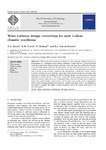Wind turbines design corrections for next Galicia climatic conditions

Use this link to cite
http://hdl.handle.net/2183/36626
Except where otherwise noted, this item's license is described as © 2017 Sharif University of Technology.
Attribution Creative Commons BY License
Collections
Metadata
Show full item recordTitle
Wind turbines design corrections for next Galicia climatic conditionsDate
2017Citation
Orosa, J.A., Costa, A.M., Roshan, G., & Garcia-Bustelo, E. (2017). Wind turbines design corrections for next Galicia climatic conditions. Scientia Iranica, 24(3), 926-932. doi: 10.24200/sci.2017.4076
Abstract
[Abstract] Galicia, placed in northwest of Spain, is a clear example of global wind energy development as a consequence of its climate conditions. Despite this fact, previous research works have indicated a climate change in the next years that must be considered at the time of wind turbine design, selection, and placement. In this work, information about weather conditions and power output from twenty four wind turbines was sampled in a typical year, and a statistic study was done. Based on this information, a model that relates weather to power conversion in this particular region and wind turbines model was obtained. This particular procedure lets us define the e
ffect of climate change over wind power on Galician wind farms. Results showed a 10% power output fall during spring and summer seasons. Therefore, future studies about new technologies that work out well under those conditions, such as low wind turbines, must be done. At the same time, results can be employed for future wind turbines placement optimization. Finally, nowadays, there is no standard or procedure to consider this highly complex situation, and so the present work aims to be the initial guide.
Keywords
Wind energy
Climate change
Moist air
Power
Wind farm
Climate change
Moist air
Power
Wind farm
Editor version
Rights
© 2017 Sharif University of Technology.
Attribution Creative Commons BY License






